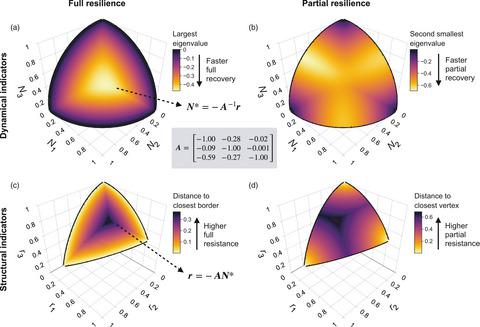当前位置:
X-MOL 学术
›
J. Anim. Ecol.
›
论文详情
Our official English website, www.x-mol.net, welcomes your feedback! (Note: you will need to create a separate account there.)
Merging dynamical and structural indicators to measure resilience in multispecies systems
Journal of Animal Ecology ( IF 4.8 ) Pub Date : 2021-02-08 , DOI: 10.1111/1365-2656.13421 Lucas P Medeiros 1 , Chuliang Song 1, 2, 3 , Serguei Saavedra 1
Journal of Animal Ecology ( IF 4.8 ) Pub Date : 2021-02-08 , DOI: 10.1111/1365-2656.13421 Lucas P Medeiros 1 , Chuliang Song 1, 2, 3 , Serguei Saavedra 1
Affiliation

|
1. Resilience is broadly understood as the ability of an ecological system to resist and recover from perturbations acting on species abundances and on the system's structure. However, one of the main problems in assessing resilience is to understand the extent to which measures of recovery and resistance provide complementary information about a system. While recovery from abundance perturbations has a strong tradition under the analysis of dynamical stability, it is unclear whether this same formalism can be used to measure resistance to structural perturbations (e.g., perturbations to model parameters). 2. Here, we provide a framework grounded on dynamical and structural stability in Lotka-Volterra systems to link recovery from small perturbations on species abundances (i.e., dynamical indicators) with resistance to parameter perturbations of any magnitude (i.e., structural indicators). We use theoretical and experimental multispecies systems to show that the faster the recovery from abundance perturbations, the higher the resistance to parameter perturbations. 3. We first use theoretical systems to show that the return rate along the slowest direction after a small random abundance perturbation (what we call full recovery) is negatively correlated with the largest random parameter perturbation that a system can withstand before losing any species (what we call full resistance). We also show that the return rate along the second fastest direction after a small random abundance perturbation (what we call partial recovery) is negatively correlated with the largest random parameter perturbation that a system can withstand before at most one species survives (what we call partial resistance). Then, we use a data set of experimental microbial systems to confirm our theoretical expectations and to demonstrate that full and partial components of resilience are complementary. 4. Our findings reveal that we can obtain the same level of information about resilience by measuring either a dynamical (i.e., recovery) or a structural (i.e., resistance) indicator. Irrespective of the chosen indicator (dynamical or structural), our results show that we can obtain additional information by separating the indicator into its full and partial components. We believe these results can motivate new theoretical approaches and empirical analyzes to increase our understanding about risk in ecological systems.
中文翻译:

合并动态和结构指标以衡量多物种系统的恢复力
1. 复原力被广泛理解为生态系统抵抗物种丰度和系统结构扰动并从中恢复的能力。然而,评估恢复力的主要问题之一是了解恢复和抵抗措施提供有关系统的补充信息的程度。虽然在动态稳定性分析中从丰度扰动中恢复具有很强的传统,但尚不清楚是否可以使用相同的形式来测量对结构扰动的抵抗力(例如,对模型参数的扰动)。2. 在这里,我们提供了一个基于 Lotka-Volterra 系统中的动力学和结构稳定性的框架,以将物种丰度的小扰动的恢复联系起来(即,动态指标)对任何量级的参数扰动具有抵抗力(即结构指标)。我们使用理论和实验多物种系统表明,从丰度扰动中恢复得越快,对参数扰动的抵抗力就越高。3. 我们首先使用理论系统来证明,在一个小的随机丰度扰动(我们称之为完全恢复)之后沿着最慢方向的返回率与系统在失去任何物种之前可以承受的最大随机参数扰动(什么是我们称之为全阻)。我们还表明,在小的随机丰度扰动(我们称之为部分恢复)之后,沿着第二快方向的返回率与系统在最多一个物种存活之前可以承受的最大随机参数扰动(我们称之为部分恢复)呈负相关。反抗)。然后,我们使用实验微生物系统的数据集来确认我们的理论预期,并证明弹性的全部和部分组成部分是互补的。4. 我们的研究结果表明,我们可以通过衡量动态(即恢复)或结构性(即阻力)指标来获得相同水平的弹性信息。无论选择何种指标(动态或结构),我们的结果表明,我们可以通过将指标分成完整和部分组件来获得更多信息。我们相信这些结果可以激发新的理论方法和经验分析,以增加我们对生态系统风险的理解。
更新日期:2021-02-08
中文翻译:

合并动态和结构指标以衡量多物种系统的恢复力
1. 复原力被广泛理解为生态系统抵抗物种丰度和系统结构扰动并从中恢复的能力。然而,评估恢复力的主要问题之一是了解恢复和抵抗措施提供有关系统的补充信息的程度。虽然在动态稳定性分析中从丰度扰动中恢复具有很强的传统,但尚不清楚是否可以使用相同的形式来测量对结构扰动的抵抗力(例如,对模型参数的扰动)。2. 在这里,我们提供了一个基于 Lotka-Volterra 系统中的动力学和结构稳定性的框架,以将物种丰度的小扰动的恢复联系起来(即,动态指标)对任何量级的参数扰动具有抵抗力(即结构指标)。我们使用理论和实验多物种系统表明,从丰度扰动中恢复得越快,对参数扰动的抵抗力就越高。3. 我们首先使用理论系统来证明,在一个小的随机丰度扰动(我们称之为完全恢复)之后沿着最慢方向的返回率与系统在失去任何物种之前可以承受的最大随机参数扰动(什么是我们称之为全阻)。我们还表明,在小的随机丰度扰动(我们称之为部分恢复)之后,沿着第二快方向的返回率与系统在最多一个物种存活之前可以承受的最大随机参数扰动(我们称之为部分恢复)呈负相关。反抗)。然后,我们使用实验微生物系统的数据集来确认我们的理论预期,并证明弹性的全部和部分组成部分是互补的。4. 我们的研究结果表明,我们可以通过衡量动态(即恢复)或结构性(即阻力)指标来获得相同水平的弹性信息。无论选择何种指标(动态或结构),我们的结果表明,我们可以通过将指标分成完整和部分组件来获得更多信息。我们相信这些结果可以激发新的理论方法和经验分析,以增加我们对生态系统风险的理解。



























 京公网安备 11010802027423号
京公网安备 11010802027423号